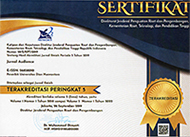GAYA RETORIKA KEPALA NEGARA RI: ANALISIS KOMPARATIF SUSILO BAMBANG YUDHOYONO (SBY) DAN JOKO WIDODO
DOI:
https://doi.org/10.33633/ja.v1i1.2682Abstract
AbstrakPenelitian ini membahas tentang kanon gaya retorika (Chanon Rethoric) kepala negara, yaitu Susilo BambangYudhoyono dan Joko Widodo. Baik Susilo Bambang Yudhoyono maupun Joko Widodo memiliki gaya retorikayang berbeda dan karakter pribadi yang masing-masing memiliki keunikan. Penelitian ini bertujuan untukmengidentifikasi gaya retorika SBY dan Jokowi, berfokus pada saat mereka memimpin Sidang KabinetParipurna. Dalam penelitian, penulis menggunakan teori kode verbal dan kode nonverbal dan menggunakanpendekatan kualitatif dengan metode analisis deskriptif dengan teknik triangulasi. Objek penelitian iniberupa video rekaman pidato SBY dan Jokowi dalam memimpin sidang kabinet paripurna. Hasil penelitianmenunjukkan bahwa dalam menyampaikan materi pidato, gaya bicara SBY teratur, kaku, dan menggunakanistilah yang panjang. SBY lebih mengutamakan kode verbal dibandingkan dengan non verbal karena mampu membentuk bahasa (langue) yaitu fonologi (tata bunyi), morfologi (pembentukan kata), dan sintaksis (pembentuk kalimat). Gerakan bahasa isyarat adaptor SBY yang paling banyak ditemui terutama objek adapteryang ditujukan pada gadget canggih yang dibawanya untuk membantunya mengingat isi materipidato. Sedangkan gaya retorika Jokowi menggunakan bahasa percakapan (parole), yaitu menggunakanbahasa keseharian dan mudah dipahami oleh semua kalangan, kata-kata yang merakyat, dan lebih to thepoint. Bahasa tubuh (body language) Jokowi juga membantu memudahkan pesan pidato dapat tersampaikandengan jelas. Hal ini menandakan bahasa non verbal kinesics lebih dominan karena ekspresi Jokowi berubahubahmengikuti pesan yang disampaikandan gerakanyangdilakukan.Kata Kunci: Kanon Retorika, Gaya Retorika, Teori Kode Verbal dan Nonverbal.AbstractThis study discusses the Chanon Rethoric head of state, namely Susilo Bambang Yudhoyono and Joko Widodo.Both Susilo Bambang Yudhoyono (SBY) and Joko Widodo have different styles of rhetoric and personal characterthat each has its own uniqueness. This study aims to identify the rhetorical style of SBY and Jokowi, focusingas they lead the Plenary Cabinet Session. In the study, the author uses verbal code theory and nonverbal codeand uses a qualitative approach with descriptive analysis method with triangulation technique. The objectof this research is a video recording of SBY and Jokowi’s speech in leading the plenary cabinet session. The results showed that in delivering speech material, SBY’s speech style is regular, rigid, and uses long term. SBY prefers verbal code compared with non verbal because it is able to form language (langue) that is phonology(sound system), morphology (word formation), and syntax (forming of sentence). The most widely used SBYadapter language gesture is particularly the object-adapter aimed at the advanced gadgets it carries tohelp him remember the content of the speech material. While Jokowi rhetoric style using the language ofconversation (parole), which uses the language of everyday and easily understood by all circles, the wordspopulist, and more to the point. Body language (body language) Jokowi also help ease speech messages canbe conveyed clearly. This indicates that non-verbal language kinesics is more dominant because Jokowi’sexpression changes with the message and movements.Keywords: Rethorical Canon, Rethorical style, Verbal Code and nonverbal TheoryDownloads
Published
2018-03-02
Issue
Section
Articles
License
Authors who publish with this journal agree to the following terms:
- Authors retain copyright and grant the journal right of first publication with the work simultaneously licensed under a Creative Commons Attribution License that allows others to share the work with an acknowledgment of the work's authorship and initial publication in this journal.
- Authors are able to enter into separate, additional contractual arrangements for the non-exclusive distribution of the journal's published version of the work (e.g., post it to an institutional repository or publish it in a book), with an acknowledgment of its initial publication in this journal.
- Authors are permitted and encouraged to post their work online (e.g., in institutional repositories or on their website) prior to and during the submission process, as it can lead to productive exchanges, as well as earlier and greater citation of published work (See The Effect of Open Access).





















